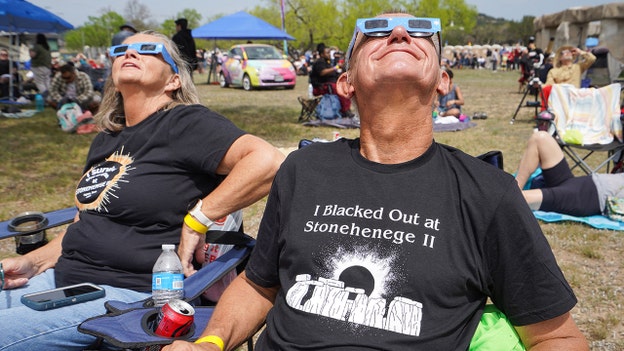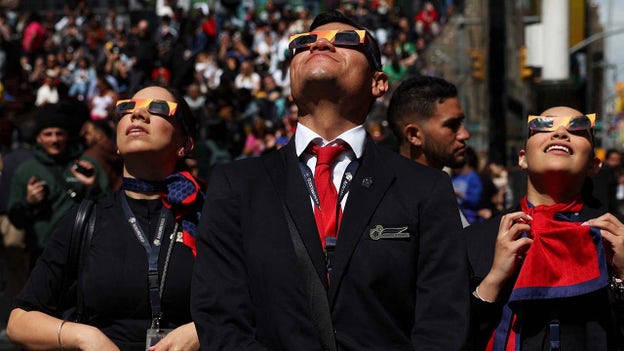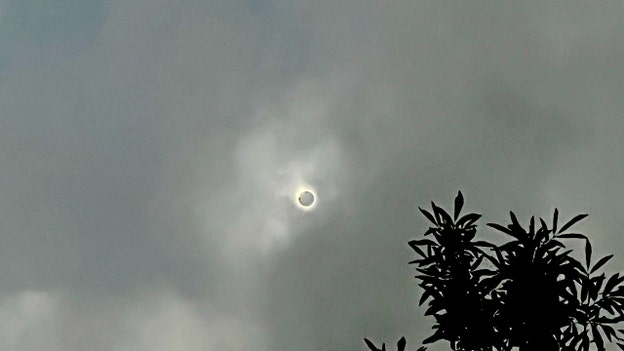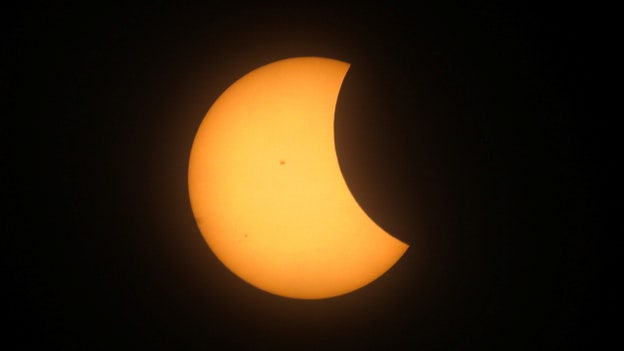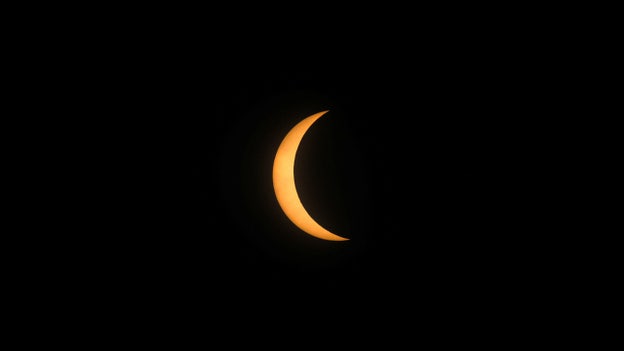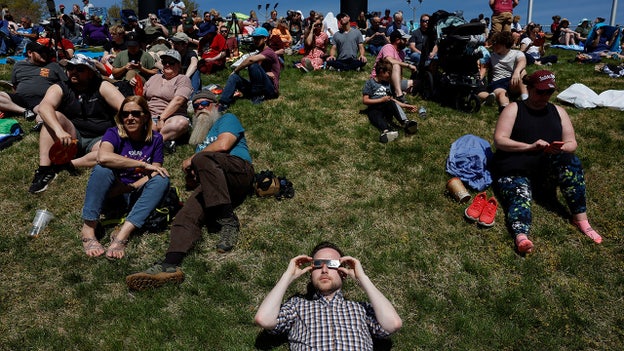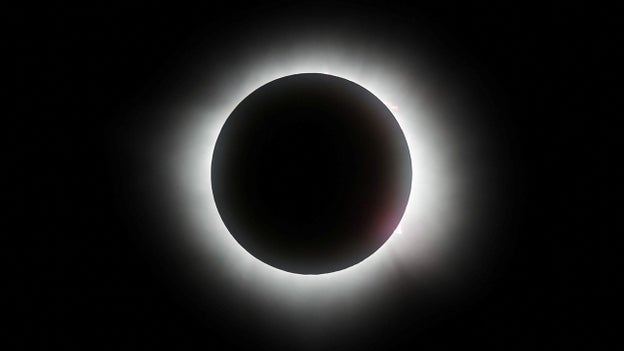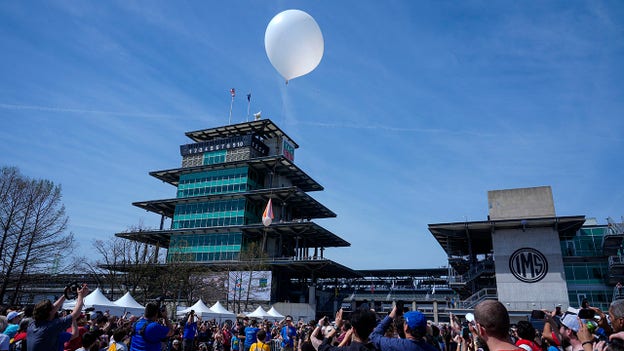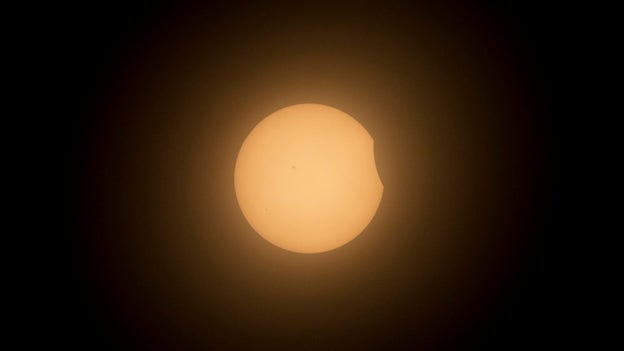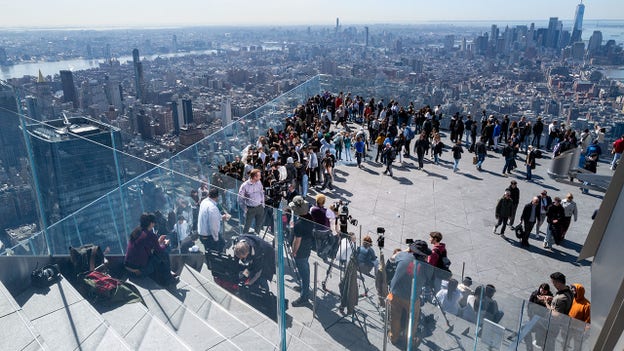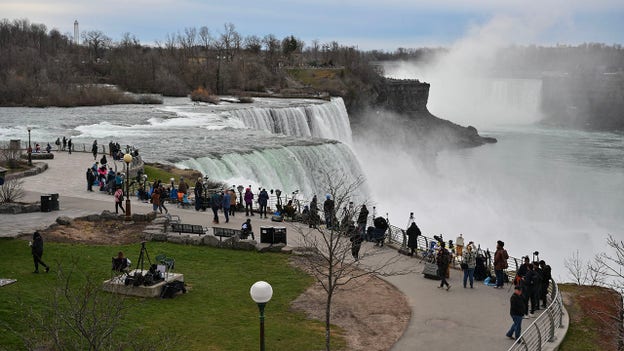Solar eclipse sweeps US, with some states in path of totality
A solar eclipse began to hit North America on Monday, April 8, with millions of Americans ready to view the rare event. The line of totality -- or where there will be complete sun coverage -- will span 15 states, but a partial eclipse will appear in all continental U.S. states, according to NASA.
Coverage for this event has ended.
Timelapse video taken by Maria Vrenko shows the 2024 total solar eclipse in a Cleveland suburb.
People gather to watch a total solar eclipse across North America, at Stonehenge II at the Hill Country Arts Foundation in Ingram, Texas, on April 8, 2024.
This year's path of totality is 115 miles wide and home to nearly 32 million Americans, with an additional 150 million living less than 200 miles from the strip. The next total solar eclipse that can be seen from a large part of North America won't come around until 2044.
A crowd of onlookers gathered in Arlington, Texas to watch the 2024 solar eclipse share the emotions they experienced. One spectator said they cried while another described it as "surreal."
Sen. Joe Manchin, D-W. Va., looks up at the solar eclipse from the base of the Senate steps of the U.S. Capitol in Washington on Monday, April 8, 2024.
A jovial crowd of onlookers broke out into cheers as the moon eclipsed the sun Monday afternoon.
People look out towards Lake Erie and the horizon during a total solar eclipse under cloudy conditions seen from Dunkirk Lighthouse & Veterans Park Museum in Dunkirk, New York, U.S., April 8, 2024.
Flight attendants stand among a crowd of onlookers in Times Square while viewing the total solar eclipse above.
2024's spectacular solar eclipse seen near Cleveland, Ohio while tracking across North America.
City officials in Mesquite, Texas cheered as the thick clouds parted in early afternoon and the sun peeked out, with the moon already taking a bite out of it.
“We special ordered the sun this morning,” downtown development manager Beverly Abell told The Associated Press.
Hundreds gathered at Front Street Station for the outdoor watch party, many pulling out their eclipse glasses to watch the moon’s bite grow ever bigger.
At the Fort Worth Zoo, clouds occasionally moved over as the eclipse started. Zoo patrons stopped along the paths to take it in.
Todd Beeby, 34, drove up with friends from Houston. He said that even with some clouds moving over, the viewing was good.
“It’s kind of neat to see it roll in and out,” he said.
A solar eclipse is drawing massive crowds throughout the U.S. Click here to see photos as Americans look to the sky to witness the event.
A total solar eclipse is expected to bring minutes of darkness to North America during the middle of the day on April 8, and it will likely be one of the most photographed events of the year.
Many Americans are already preparing to witness and capture the rare cosmic event, which some experts say won’t occur in the U.S. for another 20 years.
Since onlookers will only have a short time to capture the event, here are five tips on how to photograph the total solar eclipse.
This is an excerpt of a story by Stephen Sorace. Click here to read the full report.
People gather at Saluki Stadium, ahead of a total solar eclipse in Carbondale, Illinois on Monday, April 8, 2024.
A total lunar eclipse has ended in Mazatlan, Mexico. Crowds could be heard cheering earlier along this resort city as the moon began to pass the sun.
Hundreds in a beachside park had passed the waiting time by readying their equipment and listening to a youth orchestra play Star Wars songs while a large screen projected images of Princess Leia behind them.
The eclipse is crossing North America, darkening skies along a path through Mexico, the U.S. and Canada.
A partial solar eclipse is now underway in Indianapolis, Indiana.
The total eclipse there will happen around 3:06 p.m. ET, according to Fox News Chief Correspondent Jonathan Hunt.
A partial solar eclipse is now underway in Kerrville, Texas.
The city is along the path of totality with the maximum eclipse phase expected to be around 1:30 p.m. local time, according to NASA.
New Hampshire State Police have released a video showing extensive traffic congestion as drivers are hitting the road ahead of the solar eclipse's arrival in the state.
"Aerial video from the #NHSP Special Enforcement Unit shows drivers heading northbound via I-93 and I-89 are experiencing delays from Hooksett through the Concord area," it said in a post on X.
The eclipse will be most viewable in New Hampshire between 3 and 4 p.m. local time, according to NASA.
The moon is currently in the process of passing in front of the sun in Mazatlan, Mexico, one of the first places along the path of totality.
NASA has launched a live stream covering the event.
Shocked motorists witnessed the horrifying moment a Long Island, New York, doctor fell out the door of a moving trailer, clutching the handle before losing her grip while on her way to watch the eclipse, police said.
New York state troopers wrote in a press release that the wind caused the door of the 2024 Airstream trailer to fly open on State Route 12E in Watertown, killing 58-year-old children's allergy and immunology specialist, Dr. Monika Woroniecka.
Troopers said the doctor was on a family road trip when disaster struck around 3 p.m. on Saturday. Her husband was driving the 2019 Dodge Ram pulling the trailer at the time of the accident.
"Witnesses behind the Airstream claimed they saw the passenger side door of the Airstream open, Monika Woroniecka’s arm hanging on the door after the wind caused the door to swing open, causing her to be thrown from the Airstream," troopers wrote in their release.
New York State Police Trooper Jack Keller told Fox News Digital that the family was headed north to view the eclipse, and that Woroniecka's daughter and her daughter's boyfriend were in the trailer when the door opened.
She was flung from the trailer and struck her head on the shoulder of the roadway, police said. First responders rushed Woroniecka to Samaritan Medical Center's emergency room, where she soon succumbed to her injuries.
The White House has released a video of President Biden staring up into the sun while wearing eclipse glasses.
"Folks, enjoy the eclipse. But play it safe, don't be silly," Biden says in the video.
Biden added in a tweet to "wear protective eyewear."
The Missouri Department of Transportation says traffic along Interstate-55 heading out of the St. Louis area and toward the nearby path of totality for the upcoming solar eclipse is backed up for "about 25 miles."
"I-55 southbound is backed up to north of Meramec Bottom Road (mile marker 194) in St. Louis County for about 25 miles," it wrote on a post on X, sharing a traffic cam image of heavily congested roads. "All roads heading south out of St. Louis County and Jefferson County are experiencing heavy traffic, including Rte. 61/67 and Rte. 21."
Those onboard the Emerald Princess cruise ship, which is currently located south of Cabo San Lucas in Mexico, will be among the first to see the solar eclipse today, according to FOX Weather.
"Everybody is excited here onboard," Travel Reporter Dayvee Sutton told FOX Weather. "This is actually the second cruise ship that Princess had to book and it has been sold out. The first one was kind of like, lets see if people would book it, and it immediately sold out."
The Dallas Police Department is urging locals and tourists to "not stop on roads or highways" ahead of the upcoming solar eclipse.
The city of Dallas, which is along the eclipse's path of totality, is expected to experience the maximum eclipse phase around 1:40 p.m. local time, according to NASA.
Police there also are warning the public to "have a full tank of gas" and to "plan for travel delays."
People have started gathering on the Edge Observation Deck in New York City's Hudson Yards Monday ahead of the solar eclipse.
The line of totality — or where there will be complete sun coverage — will span 15 states, but a partial eclipse will appear in all continental U.S. states, according to NASA.
The eclipse route will travel from Mexico, arching northeast from Texas to Ohio before reaching Canada and going back into Maine.
Those in the San Antonio, Texas, area will see totality around 1:35 p.m. CT; in upstate New York, that situation will occur around 3:25 p.m. EST.
Fox News' Angelica Stabile contributed to this report.
Arkansas Gov. Sarah Huckabee Sanders tells Fox News Senior Meteorologist Janice Dean that some state parks are having "record numbers" Monday as people are streaming into the state to watch the upcoming solar eclipse.
"We hope people get out and enjoy not just the few minutes during the eclipse, but all of the things that our state has to offer while they are here over the next couple of days," she said.
Arkansas, and its capital of Little Rock, are along the eclipse's path of totality. NASA says peak viewing conditions for the eclipse there will be around 2 p.m. CT.
The city of Buffalo, New York, will experience complete totality on Monday, April 8.
"This is finally our day not in the sun," beamed Buffalo native and America’s reigning Wing King Drew Cerza, the founder of the National Buffalo Wing Festival.
"We’re celebrating by introducing a special honey-sunny Buffalo wing to help shine light on a great city and a great cause."
"Totality wings" are splashed in a brightly colored sauce of honey and mustard to represent the sun, and darkened with barbecue sauce drizzle.
They will be served on Monday at landmark Buffalo sports bar Santora’s Pizza Pub & Grill and at Highmark Stadium, home of the Buffalo Bills.
The event at Highmark Stadium, organized by Buffalo-area ophthalmologist Dr. Ephraim Atwal, will raise awareness of eye-care health and raise money for the Kelly for Kids Foundation.
The foundation was founded by Buffalo sports legend and Pro Football Hall of Fame quarterback Jim Kelly. It serves disadvantaged and disabled youth in Western New York.
American Scientist's Corey Powell joined Fox News' "The Story" late last week to preview today's upcoming solar eclipse.
"If you are right in the path [of totality'], you will get between three and four minutes of the sun completely covered by the moon," he said.
"When it's completely covered, it goes from being a weird looking sun to something like you have never seen before," Powell added. "It is a glowing circle in the sky and it is very hard to believe it is real. For the people who are right in the path, they get the best of all experiences."
A crowd has started forming at Niagara Falls Monday ahead of the solar eclipse.
The western New York city is located along the path of totality with max eclipse viewing conditions around 3:18 p.m., according to NASA.
But the National Weather Service is forecasting around 80% cloud cover for the area at that time.
Ahead of the Monday, April 8th solar eclipse, eye doctors are warning people not to look directly at the sun — which could lead to blindness and permanent eye damage.
"This can happen in less than a second from looking at the sun," Dr. Matthew Gorski, M.D., an ophthalmologist with Northwell Health on Long Island, New York, told Fox News Digital in an interview.
Another expert echoed those potential dangers.
"It is very possible that you can wind up with a permanent blind spot from viewing the eclipse without the appropriate protection," Dr. Avnish Deobhakta, M.D., a vitreoretinal surgeon at New York Eye and Ear Infirmary of Mount Sinai in New York City, told Fox News Digital.
"The eclipse is a wondrous but also dangerous event," he said. "And everyone must be vigilant during it."
Fox Weather will present special marathon coverage of Monday’s solar eclipse with "America’s Total Eclipse," featuring correspondents and meteorologists across the nation.
Fox Weather, which is FOX News Media’s free ad-supported streaming television (FAST) weather service, will offer coverage up to and throughout the first solar eclipse the country will witness in totality since August 2017.
The eclipse could last up to four minutes. Another eclipse will not occur again until 2044, according to NASA. Fox Weather meteorologists and correspondents, along with Fox News reporters, will report live across the arc of the eclipse, from Texas to Vermont, to bring Americans complete coverage of the monumental event.
Meteorologists Stephen Morgan and Kendall Smith will anchor coverage live from Dallas and the Indianapolis Motor Speedway when the eclipse occurs from 12-4 p.m. ET.
Fox News correspondent Casey Stegall will be in Dallas, senior meteorologist Janice Dean will be in Arkansas, Fox Weather correspondent Robert Ray and Fox News correspondent Jonathan Hunt will report from Indianapolis Motor Speedway, Fox Weather correspondent Brandy Campbell will be in Rochester, New York, and FOX Business correspondent Kelly Saberi will be in Bloomington, Indiana.
Fox News multimedia reporters Joy Addison, Olivianna Calmes and Kailey Schuyler will also cover the eclipse from prime viewing locations.
FOX Weather is reporting Monday that New England is expected to have the best viewing conditions for the solar eclipse -- with fewer clouds forecast -- compared to areas such as the southern Plains and Great Lakes, where cloudier skies are expected.
The National Weather Service's Albany office in New York wrote on X that "While high level clouds will be increasing this afternoon, some of them will be thin, so the eclipse may still be viewable, especially for eastern areas."
Those in the San Antonio, Texas, area will see totality around 1:35 p.m. CT; in upstate New York, that situation will occur around 3:25 p.m. EST.
Fox News' Angelica Stabile contributed to this report.
While many people are getting prepared with special solar eclipse glasses and cameras plus finalizing the logistics for the upcoming total solar eclipse, one thing may have escaped the checklist so far: ensuring that their pets are kept safe during the event.
No matter the size or age of the pet, owners should take precautions, experts say.
While four-legged family members don't need to have specialized shades — it's highly unlikely that the animals will look directly up at the sun, even if they're outside, say experts — there are still some extra steps that pet owners can take to ensure their pet's safety during the atmospheric event.
To guard against stress in animals, ASPCA Pet Health Insurance recommends that pet owners keep their furry friends inside during the solar eclipse — and to cover windows and blinds to minimize the animals' potential anxiety over the event.
The company also noted that if there is any concern that a pet has experienced eye damage due to the eclipse, owners should bring the issue to a veterinarian's notice as soon as possible.
The increased traffic and spectacle of the total solar eclipse on Monday could imperil motorists, with researchers warning that fatal collisions increased during previous eclipses and law enforcement bracing for the event.
There was a 31% increase in fatal traffic accidents during the 2017 total eclipse – and even in the days before and after the astrological event – according to a letter published in the JAMA Internal Medicine journal this week.
The surge in accidents wasn't linked to the moments of darkness when the moon obscured the sun – surprisingly, "we see a significant decrease during the single hour that involves the eclipse," co-author Dr. Donald Redelmeier wrote.
"The problem is the surrounding hours, when people are traveling to their place of observation and especially afterwards," Redelmeier, the University of Toronto professor of medicine, told Live Science. "We're especially concerned about the drive home."
Richard Fienberg, project manager of the American Astronomical Society's Solar Eclipse Task Force, told Time that the event will be "like having 20 or 30 Super Bowls happening all at once" in terms of road traffic.
As one of the biggest marvels of science, the solar eclipse carries an air of mystery — which can lead to some mistaken assumptions.
Ahead of the April 8 eclipse, Prevent Blindness, a Chicago health and safety organization dedicated to fighting blindness and saving sight, is encouraging eye safety by dispelling some common misconceptions surrounding the eclipse.
Jeff Todd, president and CEO of the organization, shared with Fox News Digital some of the biggest myths — and the truths around them.
One common misconception is the belief that it’s safe to look at the sun if it’s only for a minute or two, Todd said.
Although it is never OK to look directly at the sun, the idea that eclipses emit harmful rays that can cause blindness is also a misconception, according to Todd.
A 105-year-old Texas resident is gearing up to see the total solar eclipse on April 8 — and it's not his first rodeo.
LaVerne Biser of Fort Worth said his interest in astronomy began in high school, back in the 1930s. The umbraphile, a term referring to people who chase eclipses, spent his childhood admiring stars from his parent's Troy, Ohio, farmland in the 1920s, he told FOX 4 Dallas.
"Growing up, we were familiar with Orion’s shield, the Big Dipper … all the G5 constellations," he said.
But it wasn't until 1963 that he saw his first total solar eclipse — and he was hooked.
"You see one, you want to see them all and will do everything you can to see them," Biser said.
"They're so beautiful."
Biser and his wife, Marion, who died at age 97 in 2023, enjoyed traveling and watching eclipses as a couple.
A rare occurrence in orbit could lead to some strange happenings here on Earth.
The North American solar eclipse on April 8, 2024, is expected to hit totality in 15 U.S. states.
What can Americans expect to happen in the sky as well as on the ground?
Eclipse events can cause weird weather conditions, radio interference and changes in animal behavior.
During an eclipse, local animals and birds often "prepare for sleep or behave confusedly," according to the University of Dallas.
The changing orientation of the sun’s light also can cast some pretty cool shadows on Earth.
America’s total solar eclipse is happening. And, for the first time in many years, it could be coming to a city near you!
On Monday, April 8th, the path of totality will cover many major cities including Dallas, Indianapolis, Buffalo, Rochester and Cleveland.
This time around, the path of totality is much wider than it was in 2017, stretching 122 miles as opposed to 71 miles. Fifteen states will be included from Texas to Maine.
The basic story behind the solar eclipse is simple: The moon as it orbits around the earth passes in front of the sun every now and then.
When that happens, the sun’s light is temporarily blocked and the result is a solar eclipse. If the sun is completely covered, that is a total eclipse.
Because the moon's orbit is tilted, this type of event only happens a few times a year, and most times the alignment is not exact, so many eclipses are just partial ones. But the coolest (or in this case hottest) part of this moment (if the weather co-operates) is the ability to witness the sun’s corona (meaning "crown" in Latin) as totality occurs.
A solar eclipse will hit North America on April 8, 2024, with millions of Americans already gearing up for the rare event.
The line of totality — or where there will be complete sun coverage — will span 15 states, but a partial eclipse will appear in all continental U.S. states, according to NASA.
The eclipse route will travel from Mexico, arching northeast from Texas to Ohio before reaching Canada and going back into Maine.
The best times to view will vary per location.
Those in the San Antonio, Texas, area will see totality around 1:35 p.m. CT; in upstate New York, that situation will occur around 3:25 p.m. EST.
Live Coverage begins here
